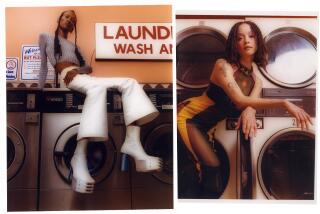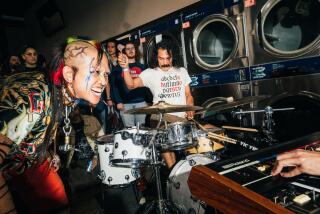Drab decor in laundromats is giving way to alluring amenities
- Share via
Customers toting pockets of quarters to a new laundromat next wash day might be in for a surprise.
Many laundromats have switched to prepaid plastic cards — like gift cards — that operate the washers and dryers. Some new laundromats are providing free wireless Internet, flat-screen televisions and attendants who sell services and are ready to help out if anything goes wrong.
It’s part of a trend to spruce up an industry long touted as a collect-your-quarters-and-leave opportunity for investors.
“People who haven’t been into a laundry since college” might not recognize the place, said Brad Steinberg, development director at PWS-the Laundry Co. of Los Angeles, a major equipment distributor and builder of self-serve laundries, a $5-billion-a year industry. “They are sexy, they are innovative … they are hip and they are modern.”
The Laundromat of Highland Park on York Boulevard, for instance, is outfitted with stainless-steel appliances and offers free Wi-Fi. The walls are lined with flat-screen televisions tuned to different channels. The bathrooms are clean.
“I’ve been coming here to wash clothes since it opened, maybe about two years ago. First, because it was cleaner than the other places I used to go to, and there are TVs with lots of different shows,” said Cecilia Avila, 37, a stay-at-home mom who lives in Eagle Rock. “It makes it comfortable to wait. My kids, they want to come all the time. I used to go to other places, but they were really small and not as clean.”
It takes more than functional washers and dryers to keep up with the competition.
“Compared to other laundromats, this one is pretty nice,” said Matt Tagayun, a 22-year-old bicycle shop salesman who was doing his wash at the Highland Park laundry. “I would still come here if it cost more than other laundromats. It doesn’t, though.”
In Sherman Oaks, the Oaks Express Laundry Center opened last fall with banks of high-capacity, front-load washers, a full-time attendant and a card payment system that enables the owner to add bonus dollars to customers’ cards, tweak individual machine prices electronically and track machine use via remote computer.
It’s a formula owner Art Jaeger came up with after building four other laundries.
“I build laundromats that are intended to attract people that ordinarily might not go into a laundromat,” said Jaeger, a former record company executive. He said his per-store revenue is in the top 10% for the industry.
Chad Hage, who just opened the renovated Lucy’s Laundromat near downtown Los Angeles, said his new energy-efficient machines and amenities that include high-end TVs and a water vending machine as well a full-time person on site, cost more but he hasn’t hesitated to charge more, either. In the long run, customers will stick with a well-run store, he said.
“We are in business to make money, but we spend the money” too, said Hage, who used profit from his wholesale cellphone business to buy the two laundries he now owns.
The industry has seen an influx of new investors unhappy with stock market returns or other business opportunities, said Paul Partyka, editor of American Coin-Op, a monthly trade magazine in Chicago.
“They have brought more business expertise with them, and as a result we are seeing slightly larger stores, slightly more ornate stores and more showcase stores than at any other time,” he said.
The changes are coming as some laundromats are closing, typically because of neglectful owners, operators said.
Jaeger got into the business after attending an industry trade show.
Like many other recent new investors in the old industry, he was impressed with the possibilities offered by the new card systems, the potential of larger-scale stores and the efficiencies of the latest machines.
“I realized,” Jaeger said, “that the business was on the cusp of changing.”



